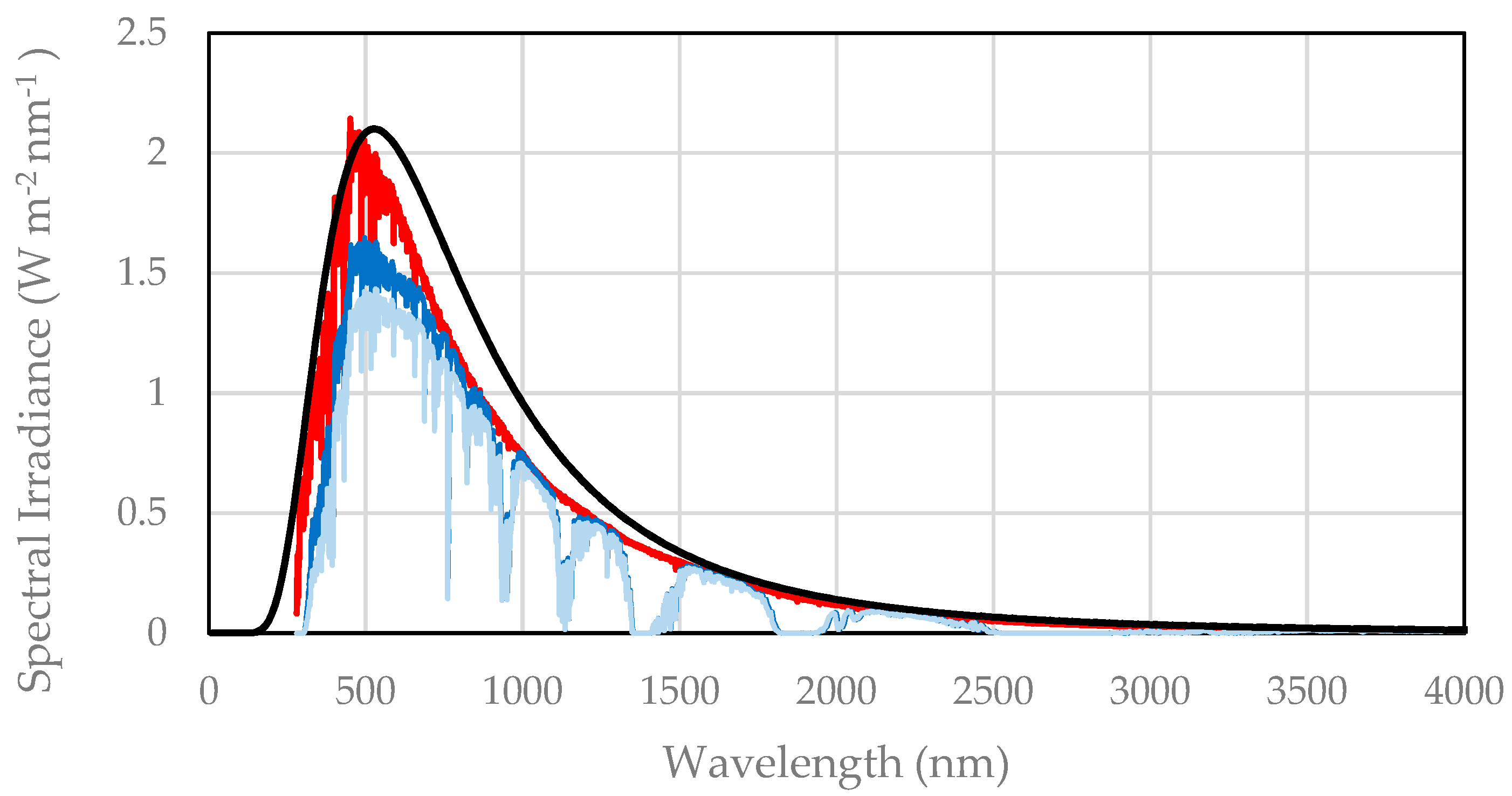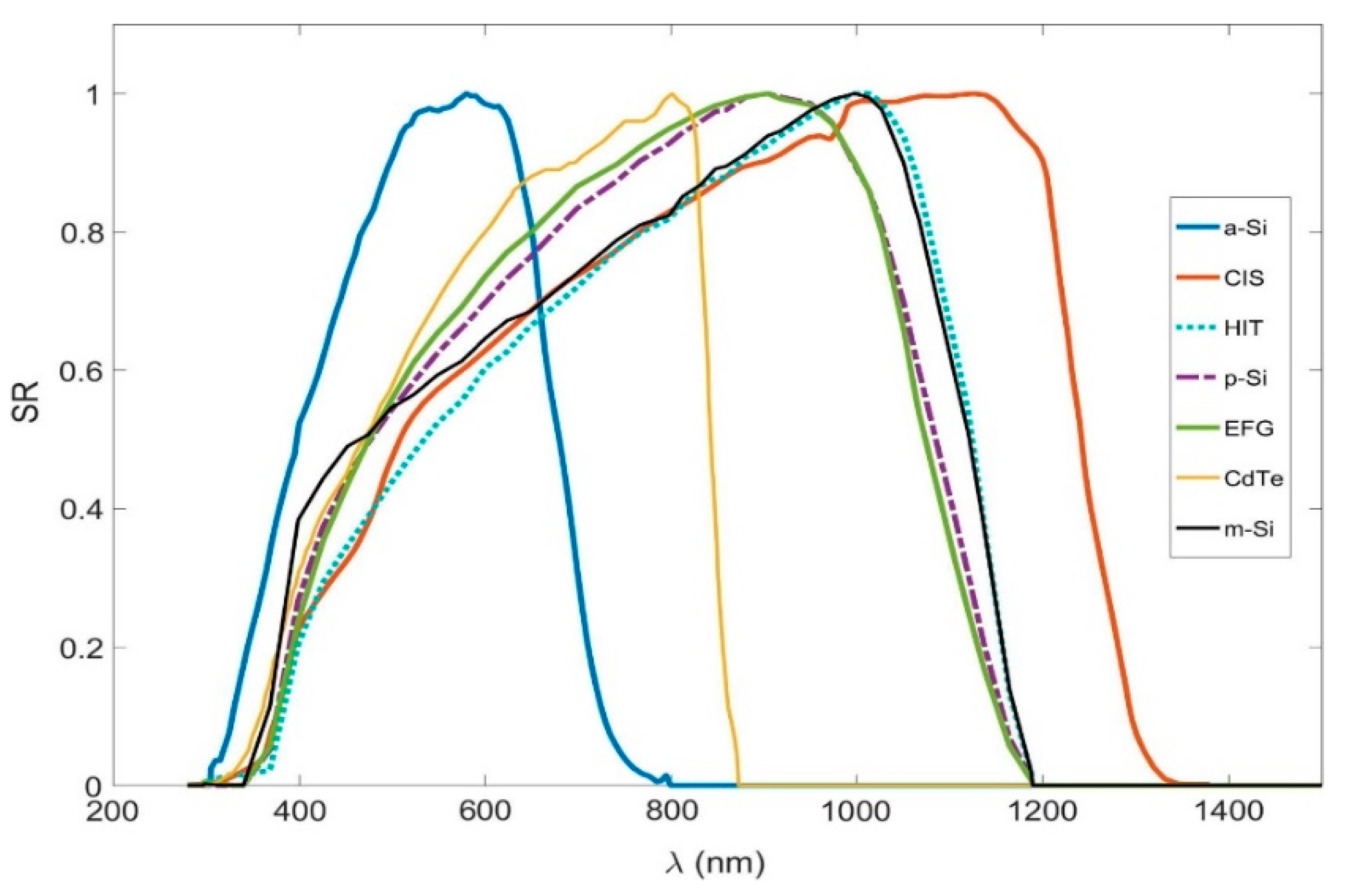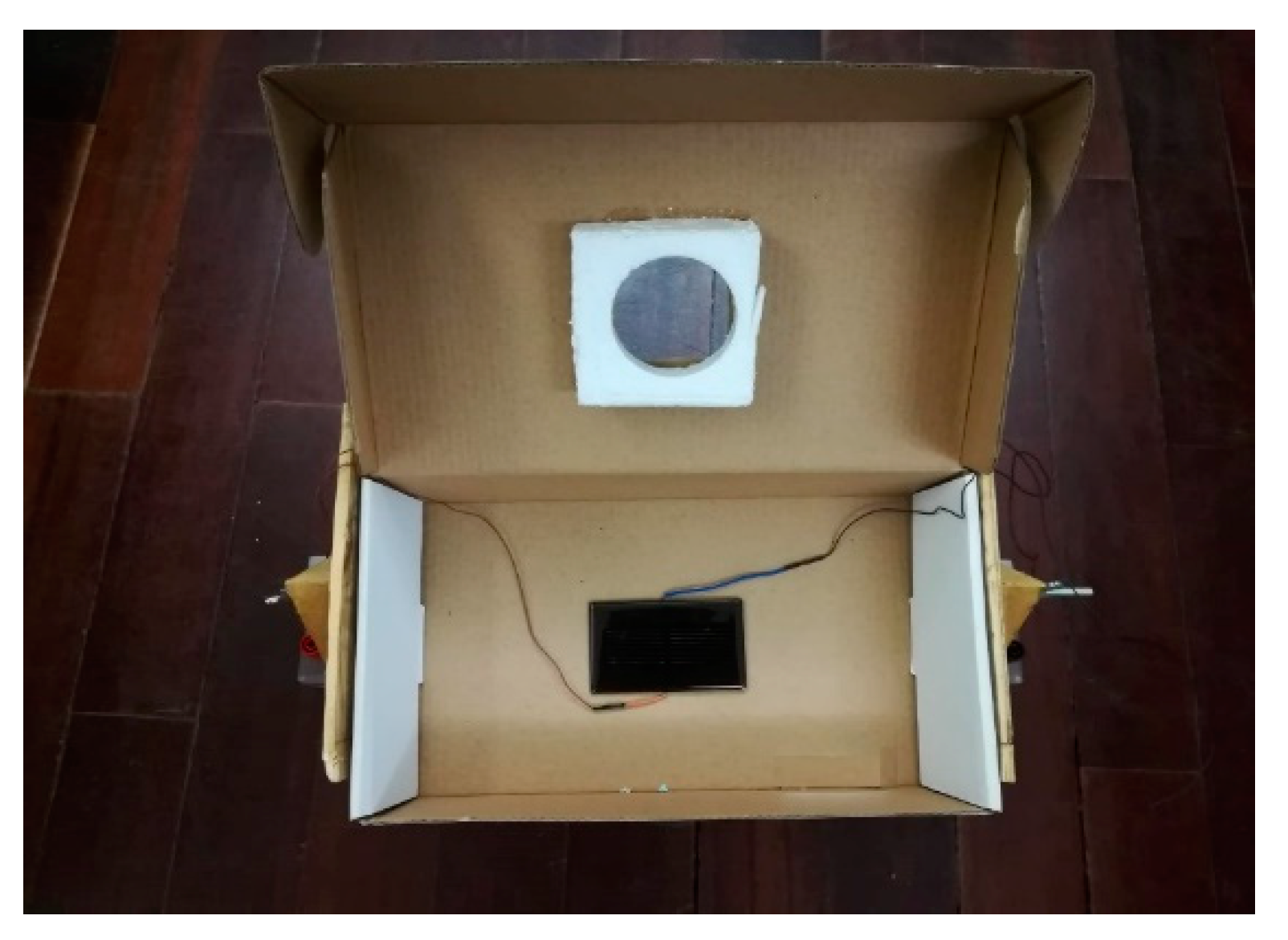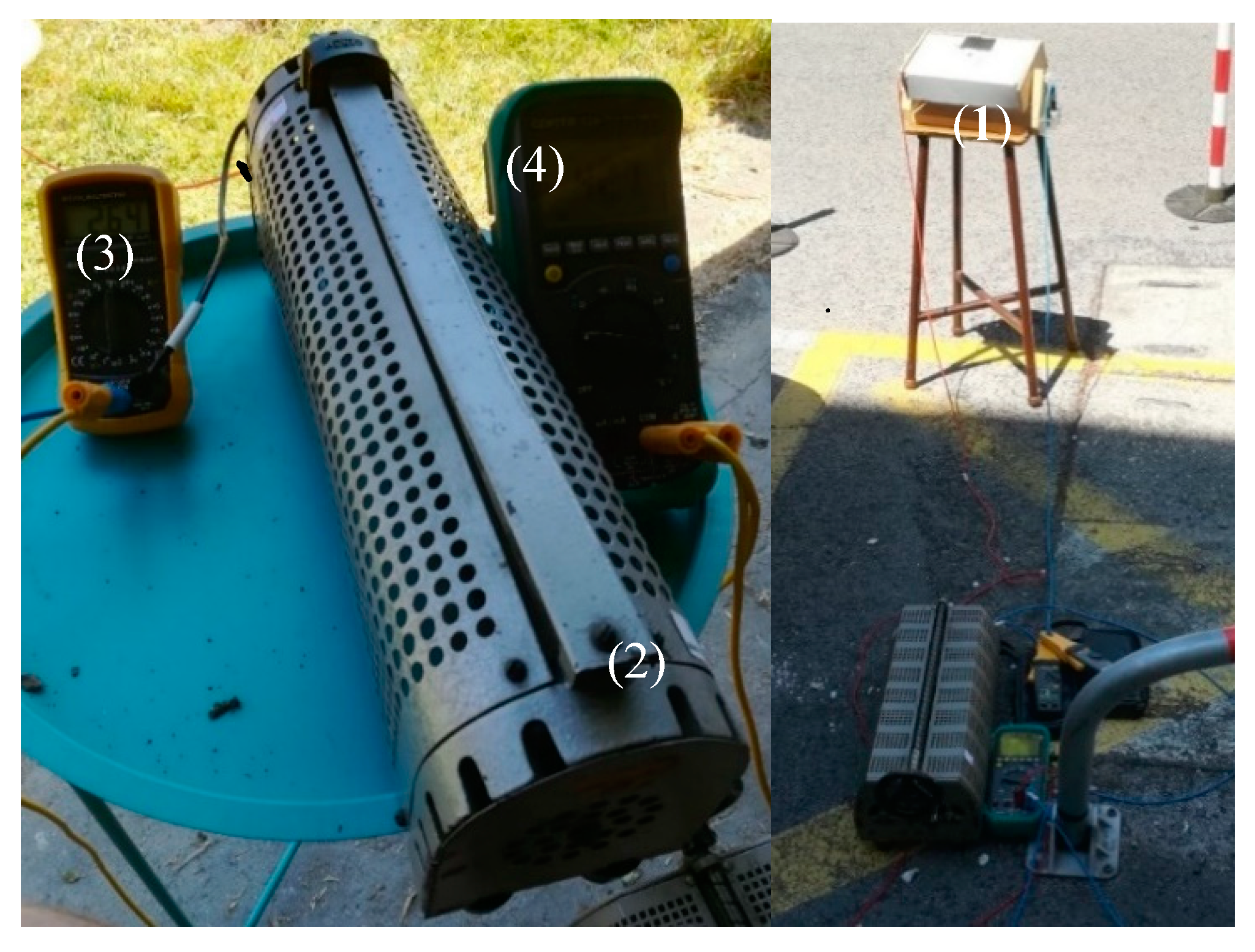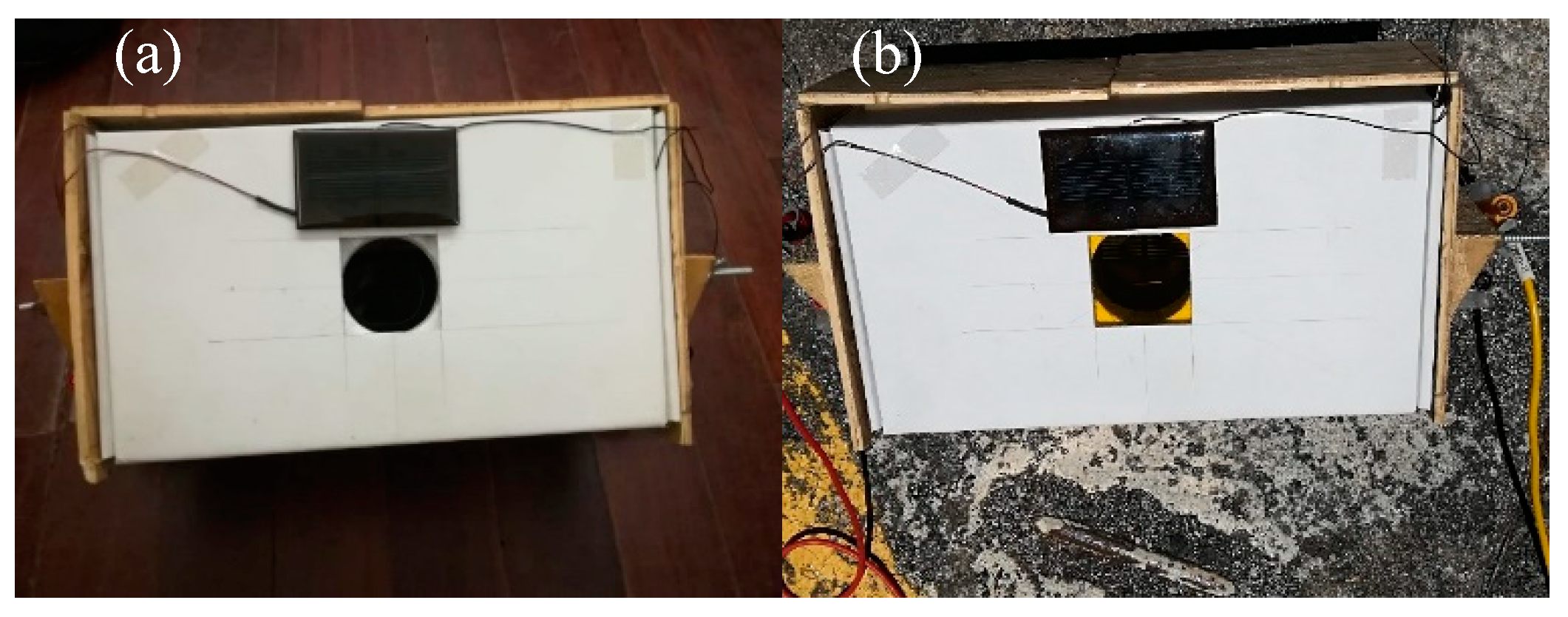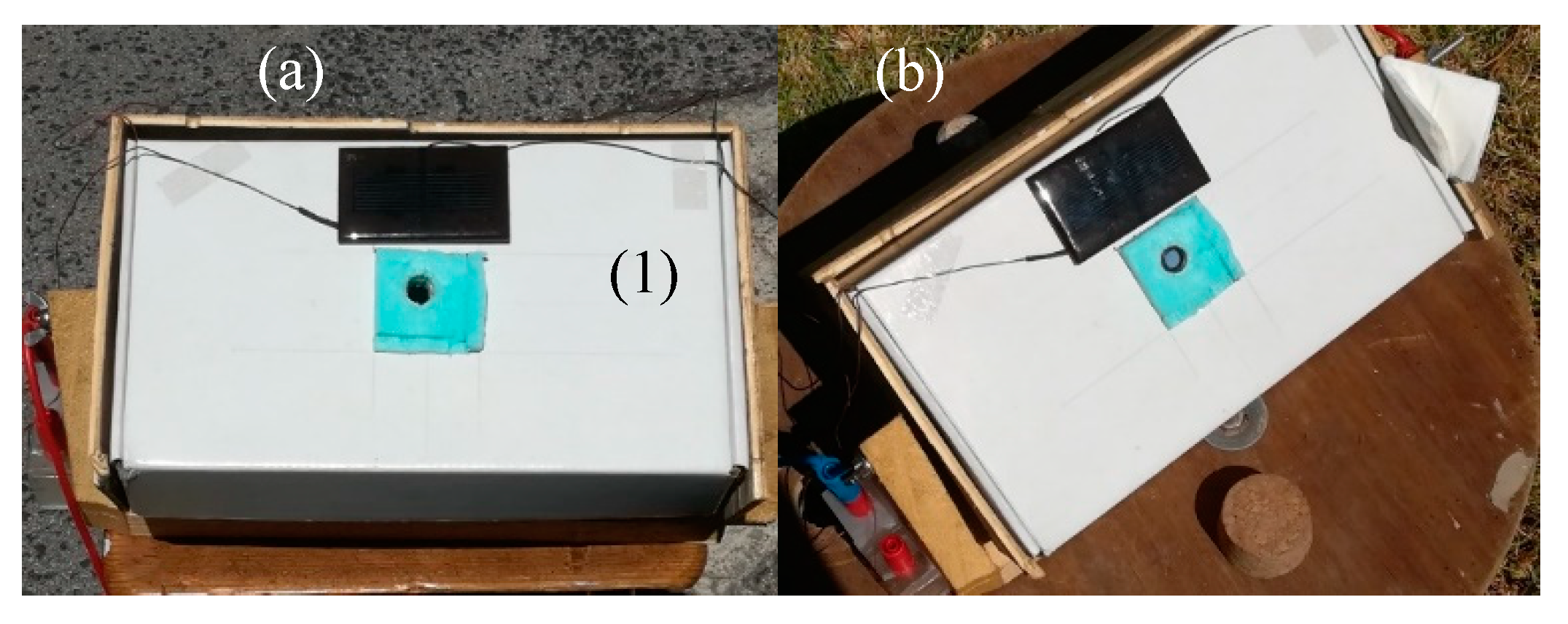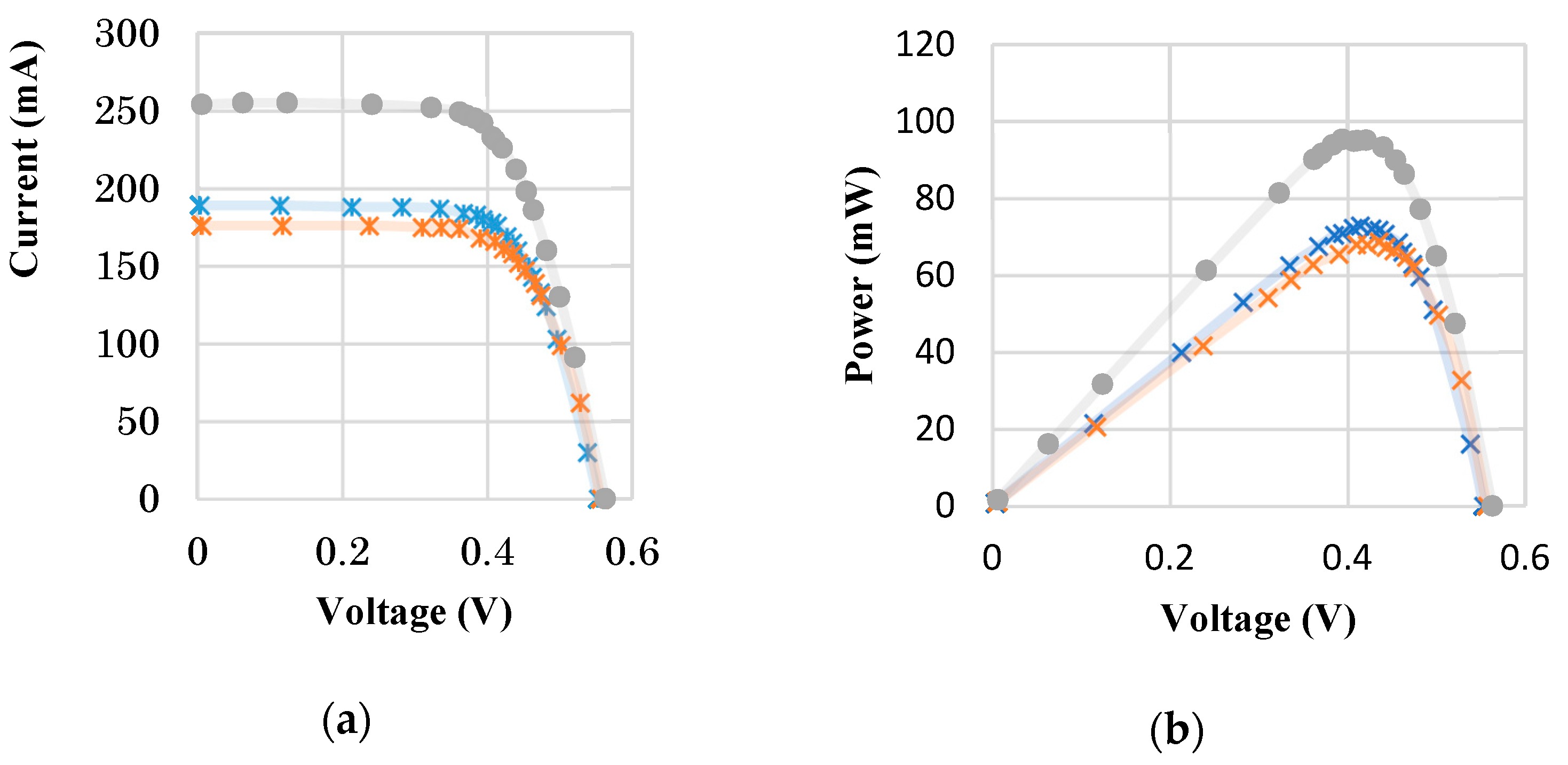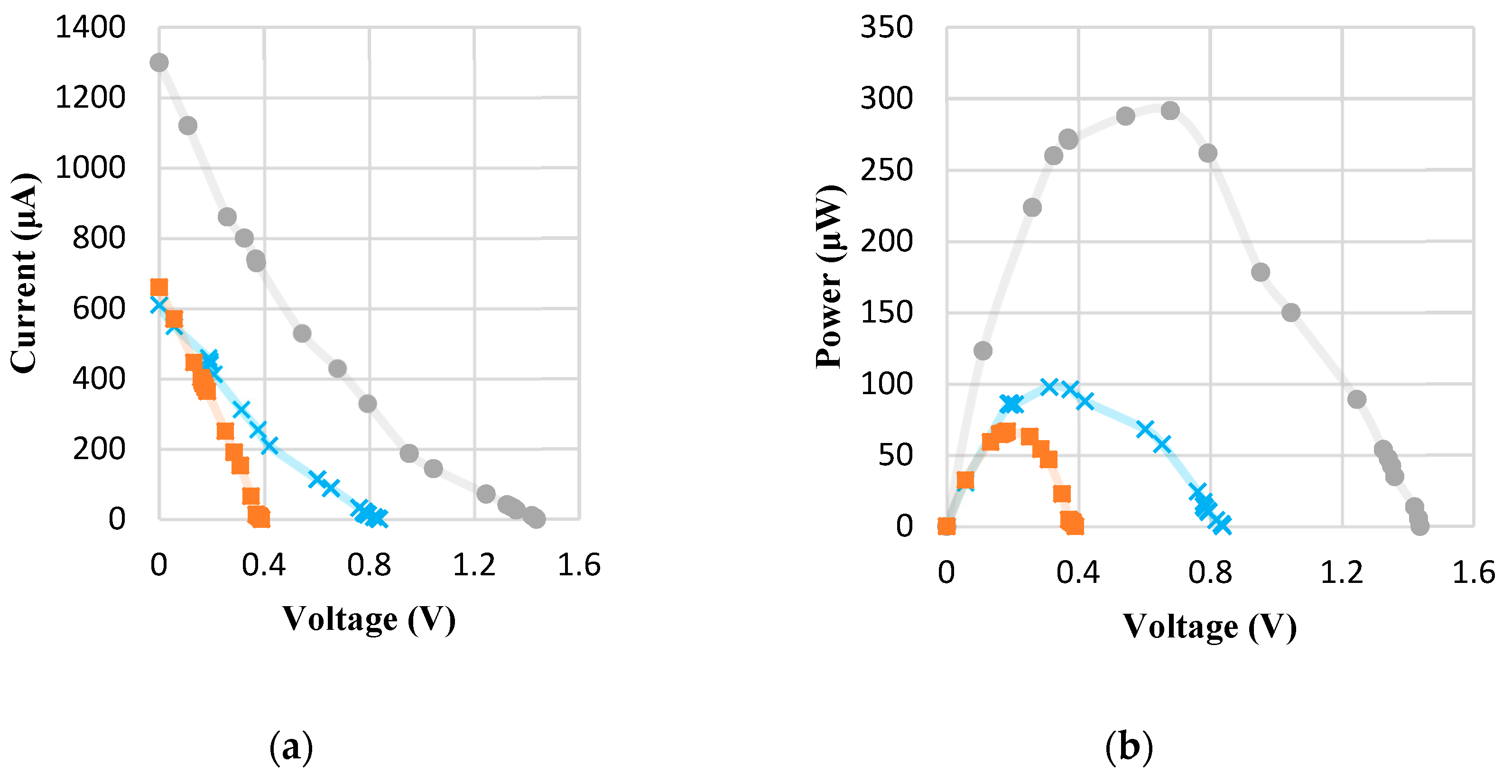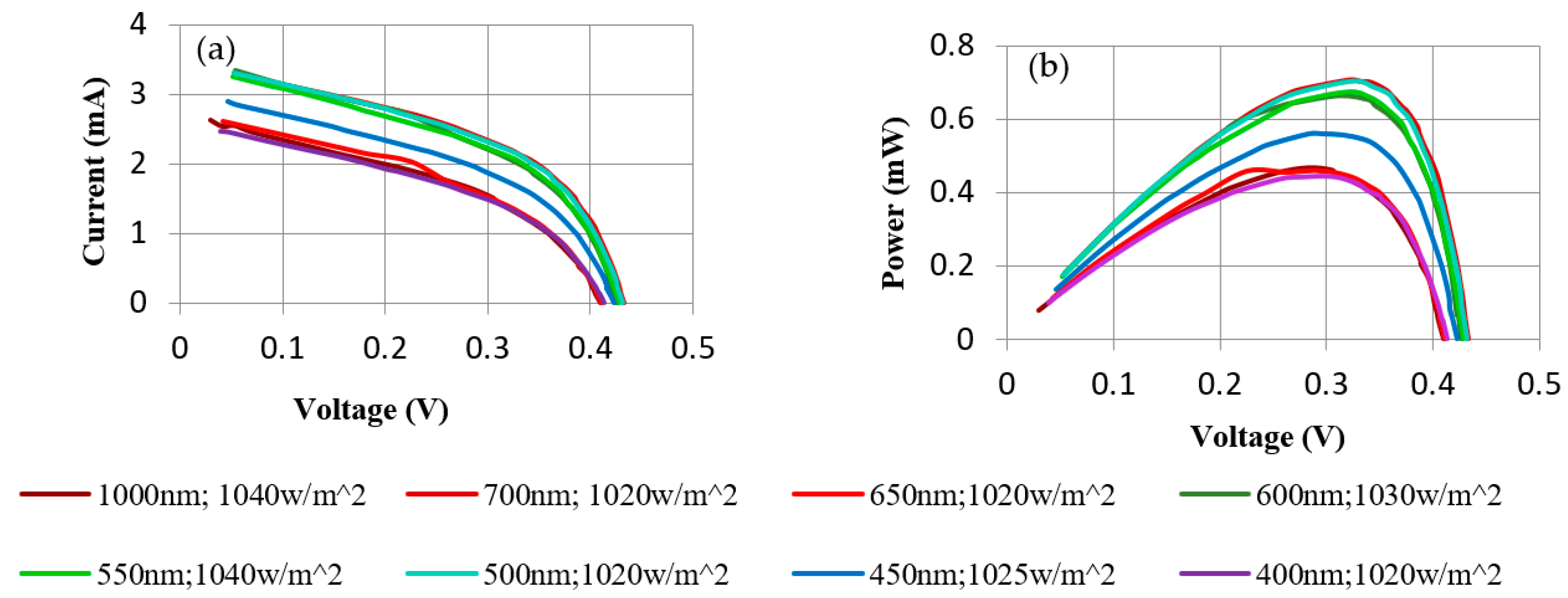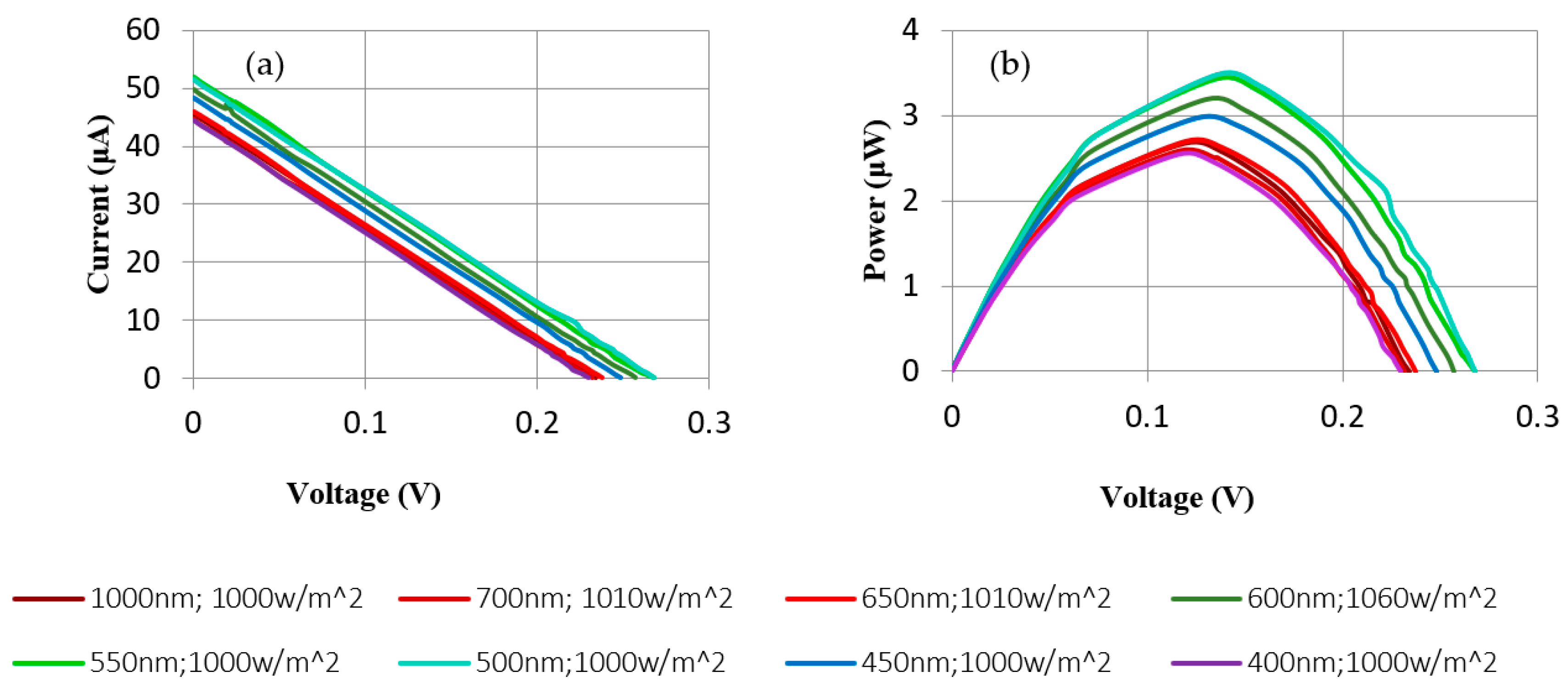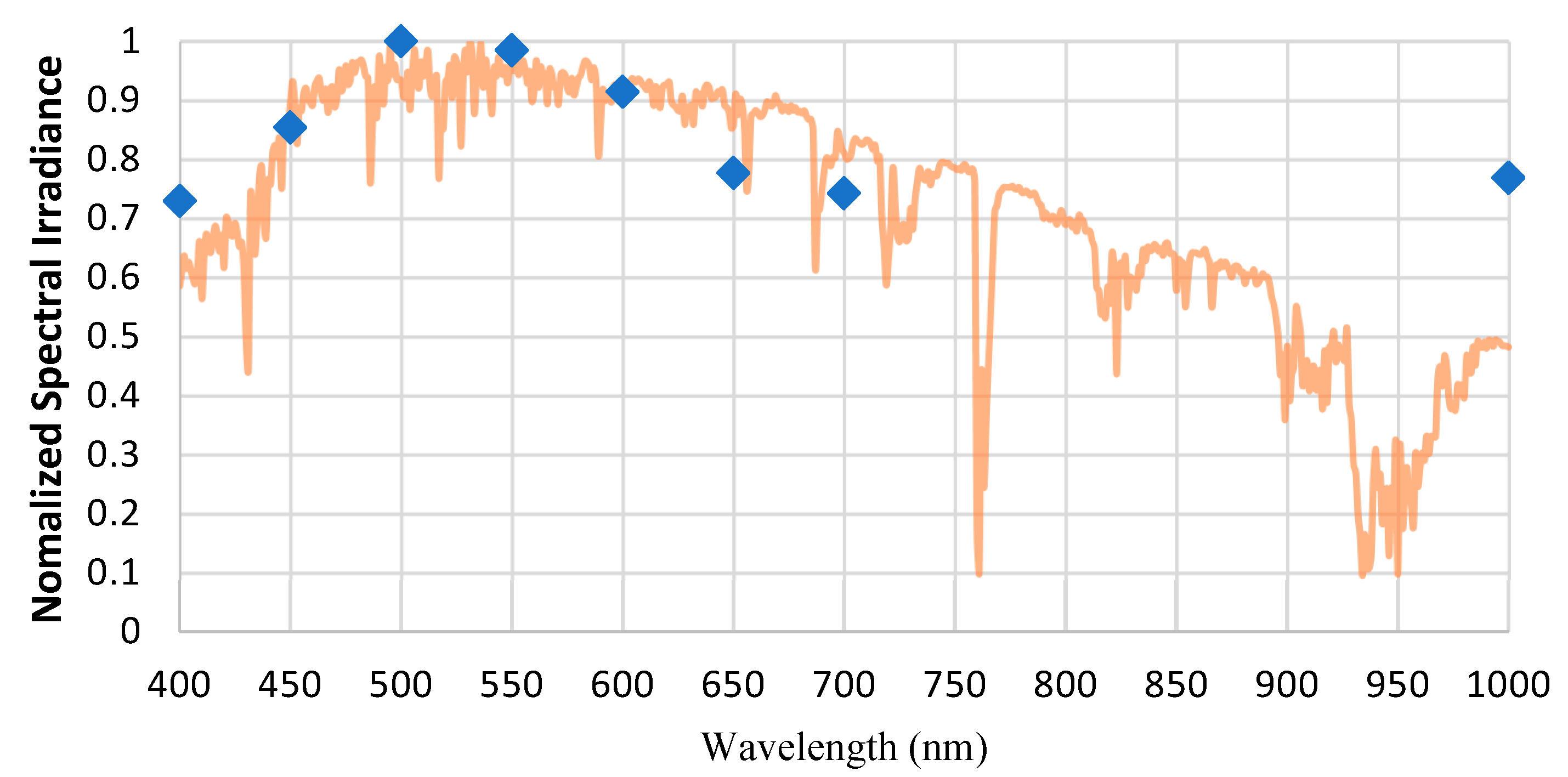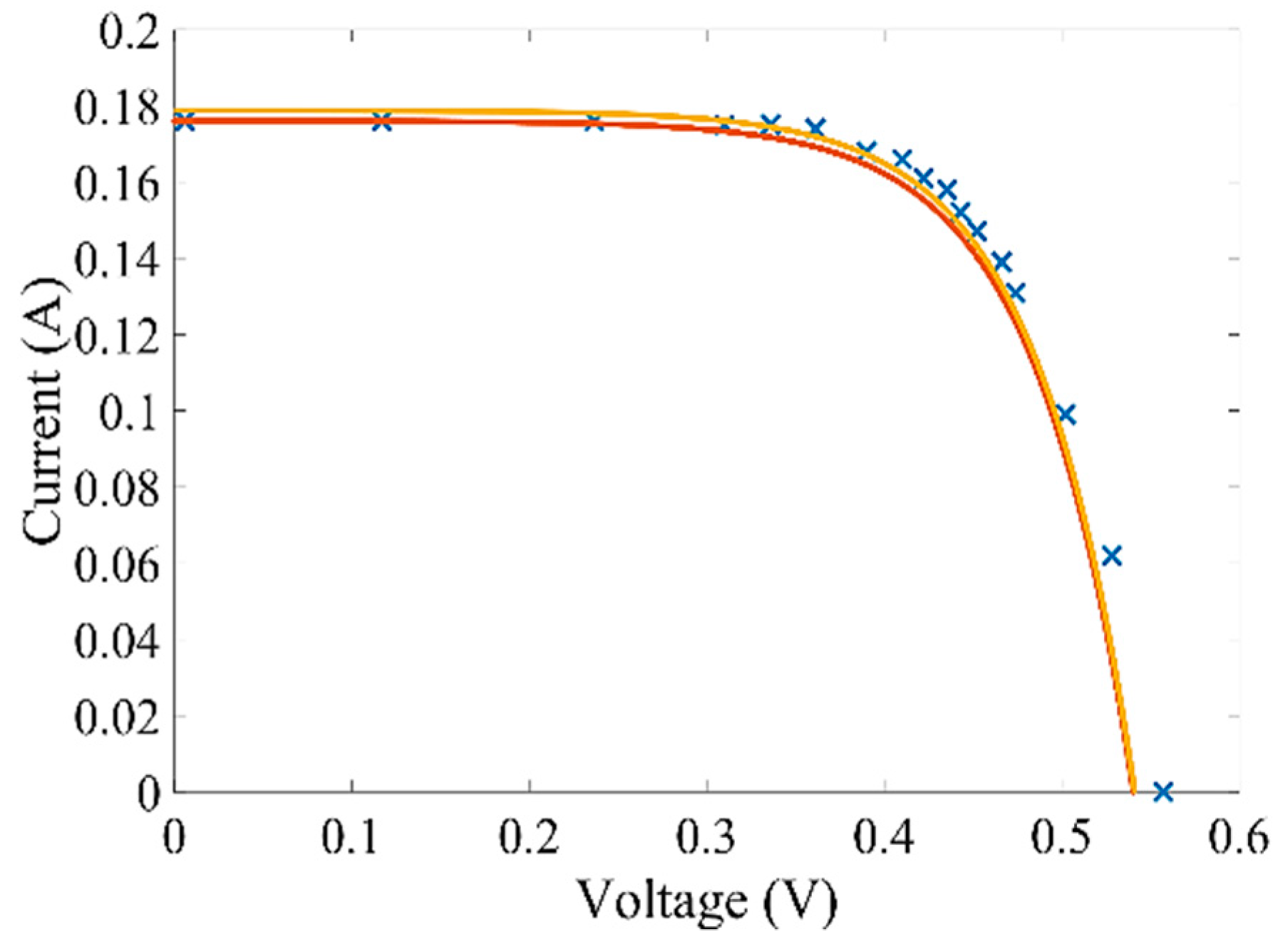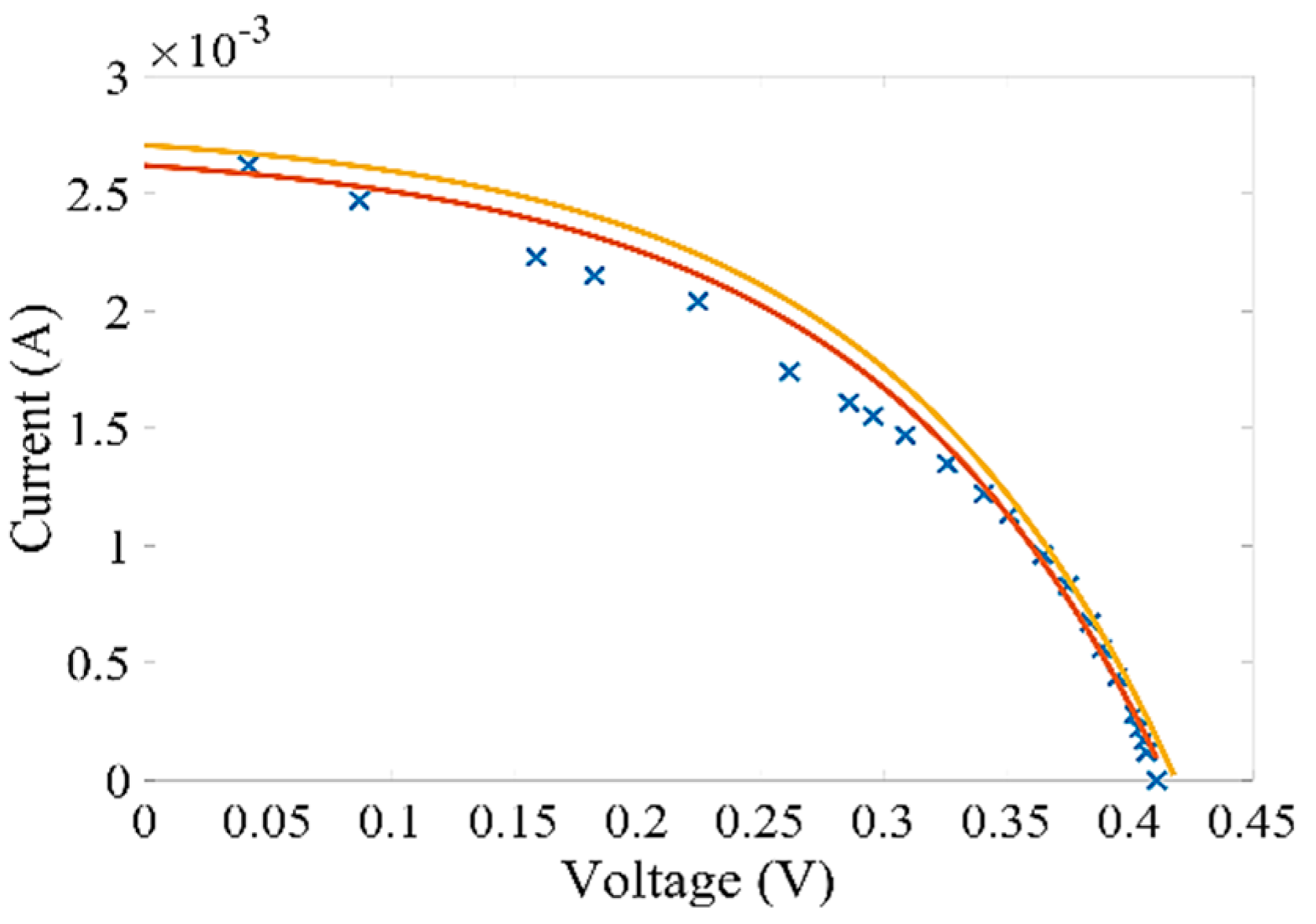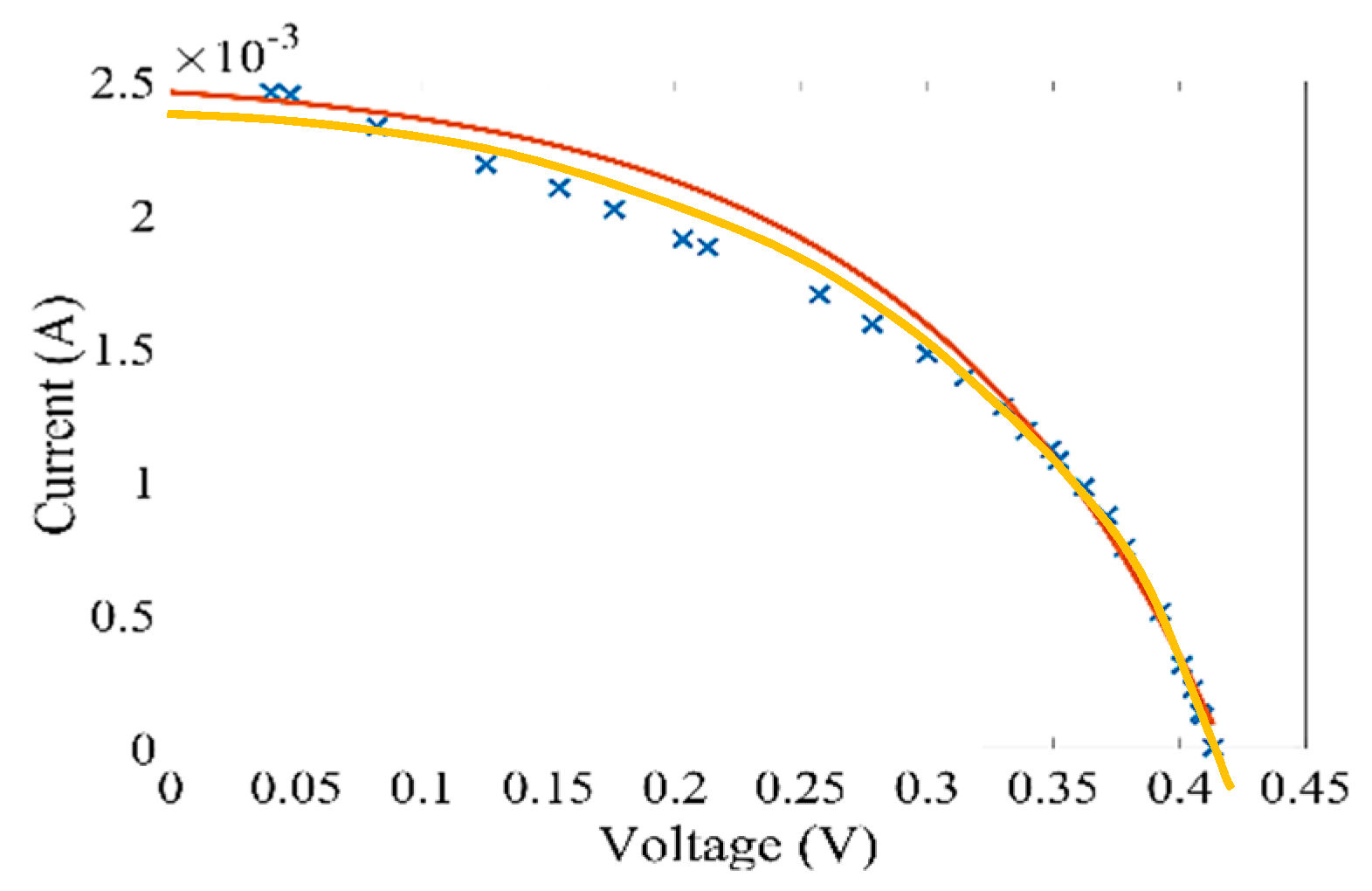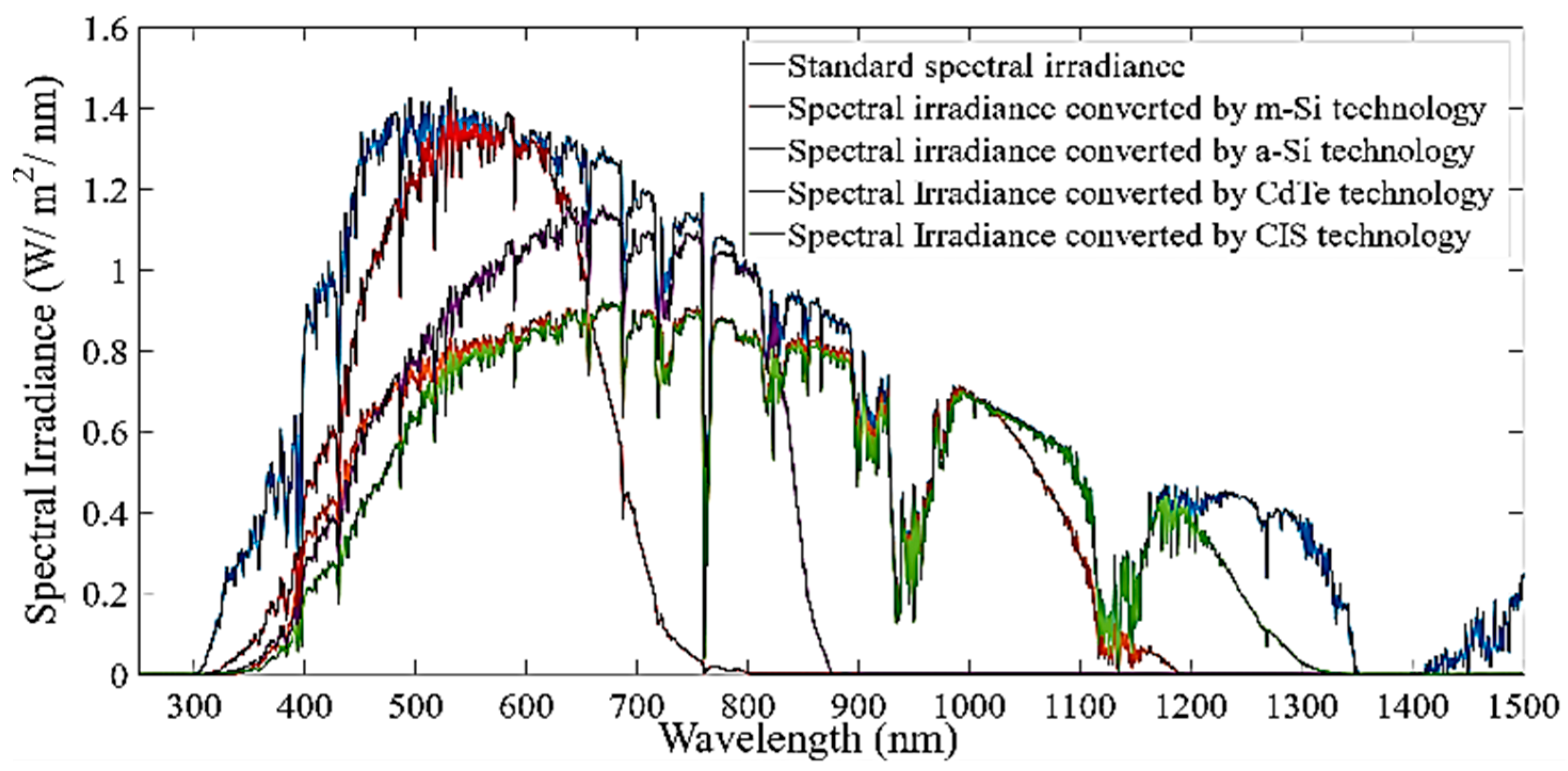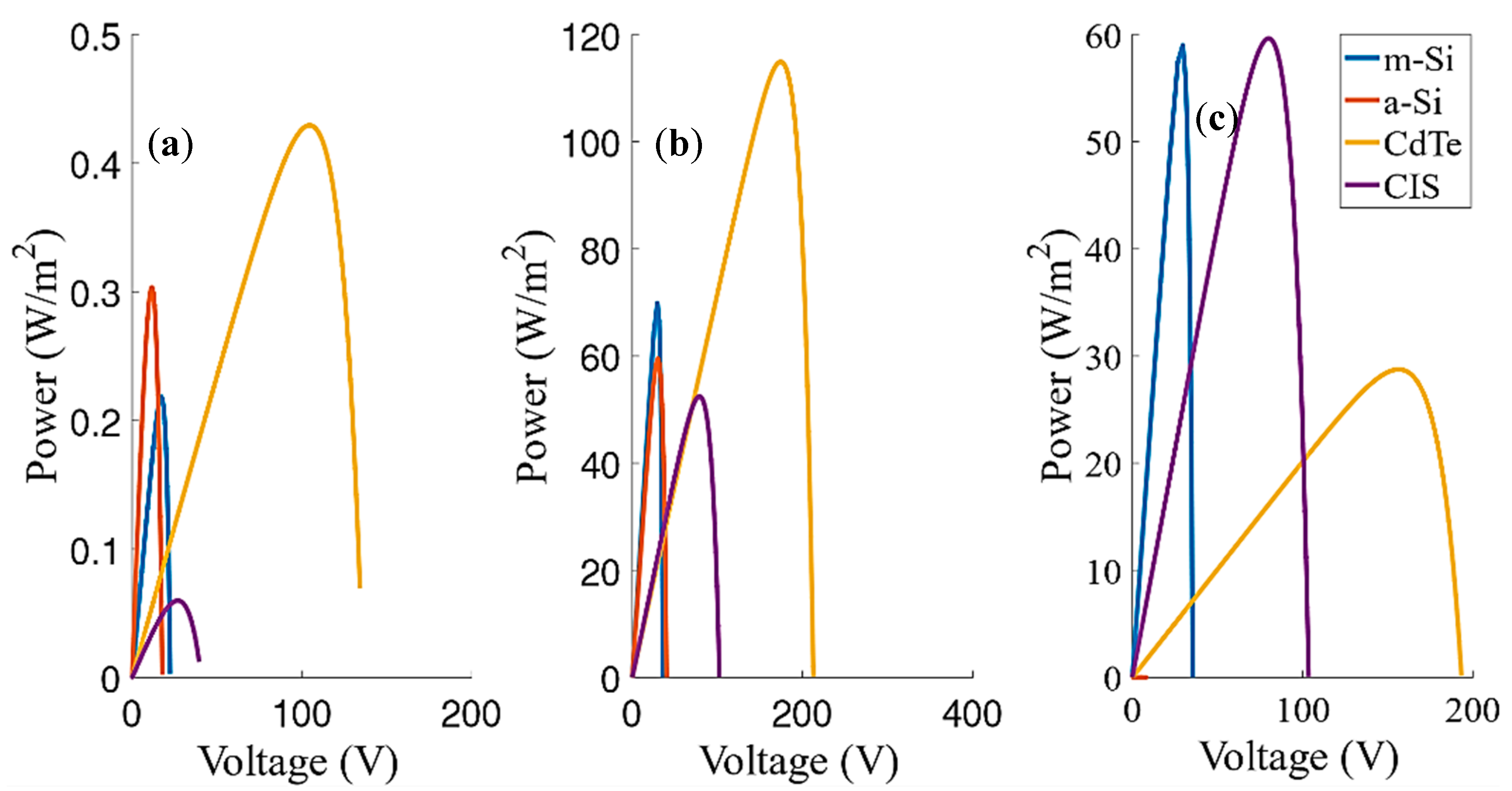Figure 1.
Plot of the direct normal spectral irradiance, AM1.5 (
___); global total spectral irradiance on a 37° tilted sun-facing surface, AM1.5 (
___); the extraterrestrial spectrum, AM0 (
___); and the blackbody irradiation spectrum at 5500 K (
___) [
10,
11].
Figure 1.
Plot of the direct normal spectral irradiance, AM1.5 (
___); global total spectral irradiance on a 37° tilted sun-facing surface, AM1.5 (
___); the extraterrestrial spectrum, AM0 (
___); and the blackbody irradiation spectrum at 5500 K (
___) [
10,
11].
Figure 2.
Spectral response for various technologies [
6].
Figure 2.
Spectral response for various technologies [
6].
Figure 3.
Open structure, with m-Si cell.
Figure 3.
Open structure, with m-Si cell.
Figure 4.
Scheme of the assemblies of the experiments.
Figure 4.
Scheme of the assemblies of the experiments.
Figure 5.
Experimental assembly. (1) Structure; (2) variable resistance; (3) ammeter and (4) voltmeter.
Figure 5.
Experimental assembly. (1) Structure; (2) variable resistance; (3) ammeter and (4) voltmeter.
Figure 6.
Structure. (a) No high-pass (HP) filters; (b) with HP filters.
Figure 6.
Structure. (a) No high-pass (HP) filters; (b) with HP filters.
Figure 7.
Structure. (a) No band-pass (BP) filters; (b) with BP filters. (1) BP filter.
Figure 7.
Structure. (a) No band-pass (BP) filters; (b) with BP filters. (1) BP filter.
Figure 8.
Experiments performed on 21 May 2018: without filters (—), with filter OG 515 (—), and filter OG 550 (—) for m-Si cell. (a) Voltage-current curves and (b) voltage-power curves. Both curves were acquired for G = 910 W/m2.
Figure 8.
Experiments performed on 21 May 2018: without filters (—), with filter OG 515 (—), and filter OG 550 (—) for m-Si cell. (a) Voltage-current curves and (b) voltage-power curves. Both curves were acquired for G = 910 W/m2.
Figure 9.
Tests carried out on 7 August 2018: without filters (—), with filter OG 515 (—), and those with filter OG 550 (—) for perovskite organic cell. (a) Voltage-current curves and (b) voltage-power curves. Both curves were acquired for G = 1000 W/m2.
Figure 9.
Tests carried out on 7 August 2018: without filters (—), with filter OG 515 (—), and those with filter OG 550 (—) for perovskite organic cell. (a) Voltage-current curves and (b) voltage-power curves. Both curves were acquired for G = 1000 W/m2.
Figure 10.
Tests performed with BP filters on August 21 2018 for the m-Si cell. (a) Voltage-current curves and (b) voltage-power curves.
Figure 10.
Tests performed with BP filters on August 21 2018 for the m-Si cell. (a) Voltage-current curves and (b) voltage-power curves.
Figure 11.
Tests performed with BP filters on 7 August 2018 for the perovskita organic cell. (a) Voltage-current curvesa and (b) voltage-power curves.
Figure 11.
Tests performed with BP filters on 7 August 2018 for the perovskita organic cell. (a) Voltage-current curvesa and (b) voltage-power curves.
Figure 12.
Normalized maximum power for BP filters for perovskite organic cell, in blue. Spectral irradiance normalized, in orange.
Figure 12.
Normalized maximum power for BP filters for perovskite organic cell, in blue. Spectral irradiance normalized, in orange.
Figure 13.
Experimental data acquired (x), characteristic curve that approaches the experimental data (---), and simulated characteristic curve (---), for the OG 515 filter.
Figure 13.
Experimental data acquired (x), characteristic curve that approaches the experimental data (---), and simulated characteristic curve (---), for the OG 515 filter.
Figure 14.
Experimental data acquired (x), characteristic curve that approaches the experimental data (---), and simulated characteristic curve (---), for the OG 550 filter.
Figure 14.
Experimental data acquired (x), characteristic curve that approaches the experimental data (---), and simulated characteristic curve (---), for the OG 550 filter.
Figure 15.
Experimental data acquired (x), characteristic curve that approaches the experimental data (---), and simulated characteristic curve (---), for the 650 nm filter.
Figure 15.
Experimental data acquired (x), characteristic curve that approaches the experimental data (---), and simulated characteristic curve (---), for the 650 nm filter.
Figure 16.
Experimental data acquired (x), characteristic curve that approaches the experimental data (---), and simulated characteristic curve (---), for the 400 nm filter.
Figure 16.
Experimental data acquired (x), characteristic curve that approaches the experimental data (---), and simulated characteristic curve (---), for the 400 nm filter.
Figure 17.
Spectral irradiance that is effectively converted into electrical energy by m-Si, a-Si, CdTe, and CIS technologies.
Figure 17.
Spectral irradiance that is effectively converted into electrical energy by m-Si, a-Si, CdTe, and CIS technologies.
Figure 18.
Simulated voltage-power curves for the m-Si, a-Si, CdTe, and CIS modules. (a) ultraviolet (UV) zone, 250–380 nm; (b) visible zone, 380–750 nm; and (c) infrared (IR) zone, >750 nm.
Figure 18.
Simulated voltage-power curves for the m-Si, a-Si, CdTe, and CIS modules. (a) ultraviolet (UV) zone, 250–380 nm; (b) visible zone, 380–750 nm; and (c) infrared (IR) zone, >750 nm.
Table 1.
High-pass filter characteristics.
Table 1.
High-pass filter characteristics.
| Reference | Transmission (%) | Cutting Wavelength |
|---|
| FSQ-OG550 | 90 | 550 nm |
| FSQ-OG515 | 90 | 515 nm |
Table 2.
Characteristics of bandpass filters.
Table 2.
Characteristics of bandpass filters.
| Reference | Center Wavelength | Bandwidth | Transmission (%) |
|---|
| 87-811 | 1000 nm | 25 nm | 99 |
| 84-775 | 700 nm | 50 nm | 99 |
| 84-774 | 650 nm | 50 nm | 99 |
| 84-773 | 600 nm | 50 nm | 99 |
| 84-772 | 550 nm | 50 nm | 99 |
| 84-771 | 500 nm | 50 nm | 99 |
| 84-770 | 450 nm | 50 nm | 99 |
| 84-769 | 400 nm | 50 nm | 99 |
Table 3.
Specifications of m-Si, a-Si, CdTe, and copper indium selenide (CIS) modules.
Table 3.
Specifications of m-Si, a-Si, CdTe, and copper indium selenide (CIS) modules.
| Technology | Module | Isc (A) | Voc (V) | Module Area (m2) |
|---|
| m-Si | PV-MLU255HC [21] | 8.89 | 37.8 | 1.656 |
| a-Si | SCHOTT ASI® 100 [22] | 3.85 | 40.9 | 1.450 |
| CdTe | First Solar Series 6™ [23] | 2.54 | 218.5 | 2.475 |
| CIS | SF170-S [24] | 2.2 | 112 | 1.228 |
Table 4.
Values of open circuit voltage, maximum power, and respective variations for different tests with and without HP filters for m-Si cell for an irradiance of 910 W/m2.
Table 4.
Values of open circuit voltage, maximum power, and respective variations for different tests with and without HP filters for m-Si cell for an irradiance of 910 W/m2.
| Filters | Voc (V) | ΔVoc (%) | PM (mW) | ΔPM (%) |
|---|
| No filters | 0.563 | ------ | 95.35 | ------ |
| OG 515 | 0.553 | 1.78 | 72.86 | 23.59 |
| OG 550 | 0.557 | 1.07 | 68.73 | 27.92 |
Table 5.
Values of open circuit voltage, maximum power, and respective variations for different tests with and without HP filters for perovskite organic cell for an irradiance of 1000 W/m2.
Table 5.
Values of open circuit voltage, maximum power, and respective variations for different tests with and without HP filters for perovskite organic cell for an irradiance of 1000 W/m2.
| Filters | Voc (V) | ΔVoc (%) | PM (μW) | ΔPM (%) |
|---|
| No filters | 0.180 | ------ | 292 | ------ |
| OG 515 | 0.105 | 41.7 | 97.7 | 66.50 |
| OG 550 | 0.049 | 72.9 | 66.8 | 77.09 |
Table 6.
Values of open circuit voltage, short-circuit current, maximum power, and respective variations for the tests with and without BP filters of m-Si cell for an irradiance of 1000 W/m2.
Table 6.
Values of open circuit voltage, short-circuit current, maximum power, and respective variations for the tests with and without BP filters of m-Si cell for an irradiance of 1000 W/m2.
| Filters | Voc (V) | ΔVoc (%) | Isc (mA) | ΔIsc (%) | PM (mW) | PM (%) |
|---|
| No filters | 0.500 | ---- | 23.0 | ---- | 6.647 | 100 |
| 1000 ± 25 nm | ---- | ---- | ---- | ---- | 0.93 | 14.05 |
| 1000 nm | 0.410 | 18.0 | 2.63 | 88.51 | 0.467 | 7.02 |
| 700 nm | 0.433 | 13.4 | 3.30 | 85.59 | 0.708 | 10.66 |
| 650 nm | 0.411 | 17.8 | 2.62 | 88.56 | 0.461 | 6.93 |
| 600 nm | 0.426 | 14.8 | 3.34 | 85.42 | 0.665 | 10.00 |
| 550 nm | 0.428 | 14.4 | 3.25 | 85.81 | 0.674 | 10.13 |
| 500 nm | 0.432 | 13.6 | 3.30 | 85.59 | 0.704 | 10.59 |
| 450 nm | 0.423 | 15.4 | 2.89 | 87.38 | 0.560 | 8.42 |
| 400 nm | 0.413 | 17.4 | 2.46 | 89.26 | 0.444 | 6.68 |
Table 7.
Values of open circuit voltage, short-circuit current, maximum power, and respective variations for the tests with and without BP filters of perovskite organic cell.
Table 7.
Values of open circuit voltage, short-circuit current, maximum power, and respective variations for the tests with and without BP filters of perovskite organic cell.
| Filters | Voc (V) | ΔVoc (%) | Isc (µA) | ΔIsc (%) | PM (µW) | PM (%) |
|---|
| No filters | 0.561 | ---- | 11.22 | ---- | 15.70 | 100 |
| 1000 ± 25 nm | ---- | ---- | ---- | ---- | 5.36 | 34.11 |
| 1000 nm | 0.234 | 58.29 | 45.60 | 59.358 | 2.678 | 17.06 |
| 700 nm | 0.232 | 58.68 | 44.80 | 60.071 | 2.586 | 16.47 |
| 650 nm | 0.237 | 57.72 | 46.00 | 59.002 | 2.705 | 17.23 |
| 600 nm | 0.257 | 54.19 | 49.90 | 55.526 | 3.185 | 20.29 |
| 550 nm | 0.268 | 52.23 | 51.90 | 53.743 | 3.429 | 21.84 |
| 500 nm | 0.268 | 52.23 | 51.60 | 54.011 | 3.482 | 22.18 |
| 450 nm | 0.248 | 55.79 | 48.30 | 56.952 | 2.975 | 18.95 |
| 400 nm | 0.230 | 59.00 | 44.40 | 60.428 | 2.540 | 16.18 |
Table 8.
Average values of the short-circuit current under STC for the experiments performed with the aperture for filters used.
Table 8.
Average values of the short-circuit current under STC for the experiments performed with the aperture for filters used.
| Experience | |
|---|
| Aperture for HP filter | 0.271968 |
| Aperture for BP filter | 0.030144 |
Table 9.
Values of short-circuit current and their respective relative errors for HP filters.
Table 9.
Values of short-circuit current and their respective relative errors for HP filters.
| Day | Hour | Filter | Isc Experimental (A) | Isc SF Model (A) | Isc Model without SF (A) | Relative Error SF Model (%) | Relative Error Model without SF (%) |
|---|
| 21/5/2018 | 15h–15:50h | OG 515 | 0.189 | 0.192 | 0.183 | 1.53 | 3.33 |
| OG 550 | 0.176 | 0.179 | 0.170 | 1.59 | 3.35 |
| 15/6/2018 | 12:30h–13:30h | OG 515 | 0.208 | 0.203 | 0.193 | 2.21 | 7.45 |
| OG 550 | 0.193 | 0.191 | 0.181 | 1.30 | 6.05 |
| 15:21h–16h | OG 515 | 0.203 | 0.209 | 0.199 | 3.10 | 1.83 |
| OG 550 | 0.188 | 0.193 | 0.185 | 2.39 | 1.56 |
| 18/6/2018 | 12:42h–14:16h | OG 515 | 0.179 | 0.189 | 0.180 | 5.42 | 0.40 |
| OG 550 | 0.166 | 0.179 | 0.170 | 5.30 | 2.48 |
| 19/6/2018 | 12:23h–12:45h | OG 515 | 0.180 | 0.185 | 0.176 | 2.56 | 2.38 |
| OG 550 | 0.169 | 0.179 | 0.166 | 3.43 | 1.56 |
| 13h–13:27h | OG 515 | 0.182 | 0.189 | 0.180 | 3.68 | 1.26 |
| OG 550 | 0.170 | 0.179 | 0.168 | 5.18 | 1.04 |
Table 10.
Values of short-circuit current and their respective relative errors for BP filters.
Table 10.
Values of short-circuit current and their respective relative errors for BP filters.
| Filters | Isc Experimental (mA) | Isc SF Model (mA) | Isc Model without SF (mA) | Relative Error SF Model (%) | Relative Error Model without SF (%) |
|---|
| 1000 nm | 2.63 | 2.44 | 2.53 | 7.22 | 3.8 |
| 700 nm | 3.3 | 3.0 | 3.1 | 9.09 | 6.06 |
| 650 nm | 2.62 | 2.412 | 2.53 | 7.94 | 3.44 |
| 600 nm | 3.34 | 2.99 | 3.12 | 10.48 | 6.59 |
| 550 nm | 3.25 | 3.14 | 3.23 | 3.38 | 0.62 |
| 500 nm | 3.3 | 3.12 | 3.25 | 5.45 | 1.52 |
| 450 nm | 2.89 | 2.68 | 2.82 | 7.27 | 2.42 |
| 400 nm | 2.46 | 2.38 | 2.41 | 3.25 | 2.03 |
Table 11.
Values of spectral factor (SF), spectral incompatibility factor (MM), spectral effective responsivity (SEF), and maximum power per area of each module of m-Si, a-Si, CdTe, and CIS for the UV, visible, and IR zones.
Table 11.
Values of spectral factor (SF), spectral incompatibility factor (MM), spectral effective responsivity (SEF), and maximum power per area of each module of m-Si, a-Si, CdTe, and CIS for the UV, visible, and IR zones.
| Technology | SF | MM | SEF | PM/A (W/m2) |
|---|
| UV | V | IR | UV | V | IR | UV | V | IR | UV | V | IR |
|---|
| m-Si | 0.134 | 1.098 | 1.221 | 1.00 | 1.00 | 1.00 | 0.074 | 0.607 | 0.821 | 0.218 | 69.855 | 58.998 |
| a-Si | 0.691 | 2.010 | 0.007 | 5.14 | 1.83 | 0.01 | 0.253 | 0.731 | 0.014 | 0.303 | 59.546 | 0.018 |
| CdTe | 0.226 | 1.590 | 0.579 | 1.68 | 1.45 | 0.47 | 0.100 | 0.704 | 0.793 | 0.429 | 114.914 | 28.751 |
| CIS | 0.084 | 0.964 | 1.396 | 0.63 | 0.88 | 1.14 | 0.049 | 0.557 | 0.824 | 0.060 | 52.437 | 59.638 |
